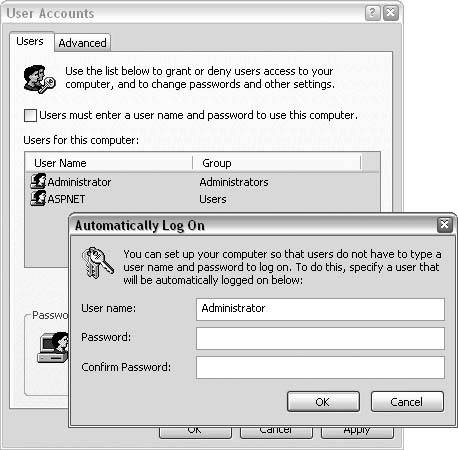Section 1.6. WELCOME SCREEN
1.6.1. Get Rid of the Welcome ScreenTHE ANNOYANCE: I'm sick of the Welcome screen. Why can't I go straight to Windows when I turn on my computer? THE FIX: You canif you're the only one using your computer. First, select a password, if you haven't done so already. Open the User Accounts control panel, choose your account from the list, click "Create a password," and then type the password you'd like to use. (Don't worry; you won't have to type it every time.) Next, go to Start Figure 1-20. Use the Alternate User Accounts window to make it so you don't have to log in every time you turn on your computer.
1.6.2. Fix the Unread Messages DisplayTHE ANNOYANCE: The Welcome screen is telling me I have unread mail. How does it know? And, besides, it's wrongnobody ever emails me. How do I get rid of this? THE FIX: Sorry to hear that. Try joining some discussion groups or something, or if you like, I can add your address to some spam lists! Regardless, the "unread messages" display only works if you're using Microsoft Outlook or Outlook Express to read your email. If you're not using either of these programs, you'll need to edit the Registry to fix the problem. Go to Start Then, on the right side, double-click the MessageExpiryDays value; if it's not there, go to Edit 1.6.3. Old-Fashioned LogonTHE ANNOYANCE: My computer is used by a lot of people, and I don't think Windows's practice of listing them all is very smart. It's a lot harder for an intruder to guess both a username and a password than only a password. Is there a way to replace the Welcome screen with a good ol' logon box? THE FIX: In the old days, people used to type in their usernames and passwords to log onto their computers (after, of course, climbing down from the mastodons that delivered them to the office). Figure 1-21. This old-fashioned logon box is more secure than the Welcome screen.
You can replace the friendly-but-not-terribly-secure Welcome screen with the old familiar logon box (Figure 1-21) via the User Accounts control panel. Click the "Change the way users log on or off" link, and then uncheck the "Use the Welcome screen" box. Click the Apply Options button when you're done. Note: Some other Windows features are affected by this setting. For instance, the Windows XP Shut Down box is also replaced with an older, no-frills version. And without the Welcome screen enabled, pressing Ctrl-Alt-Del opens the Windows Security box instead of the Task Manager. 1.6.4. Hide the Name of the Last UserTHE ANNOYANCE: I've switched to the classic logon screen, but now the username of the last person who used the computer is shown. From a security standpoint, this is not an improvement! THE FIX: To hide this username, you must dive into the Windows Registry. Go to Start 1.6.5. Un-Secure Your ScreensaverTHE ANNOYANCE: Every time my screensaver comes on, I have to type my password to make it go away. Is this necessary? THE FIX: Other than being a sure-fire way to force you to remember your own password, it's not really useful unless you work in a public environment. The idea is that if you walk away from your desk, an intruder can't poke around your system without knowing your password. If you feel that the likelihood of this happening is small, change this setting by right-clicking an empty area of your desktop, selecting Properties, and choosing the Screen Saver tab. Uncheck the "On resume, password protect" box, and click OK. There's a second option that does pretty much the same thing when your computer hibernates or goes to sleep. If you don't want Windows to send you back to the Welcome screen each time you "wake up" your PC, open the Power Options control panel (or click the Power button in Display Properties), choose the Advanced tab, and uncheck the "Prompt for password when computer resumes from standby" checkbox. Click OK, and you're done. |
 Run, type control userpasswords2, and click OK. In this different User Accounts window, shown in Figure 1-20, uncheck the "Users must enter a user name and password to use this computer" box. When prompted, type your username and password (twice), and click OK. Thereafter, you won't have to log in manually again, and the Welcome screen will be banished.
Run, type control userpasswords2, and click OK. In this different User Accounts window, shown in Figure 1-20, uncheck the "Users must enter a user name and password to use this computer" box. When prompted, type your username and password (twice), and click OK. Thereafter, you won't have to log in manually again, and the Welcome screen will be banished.






